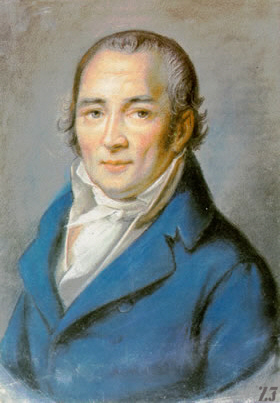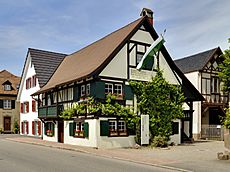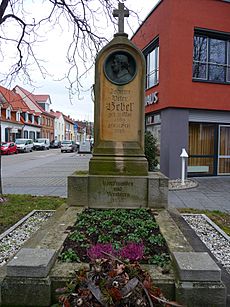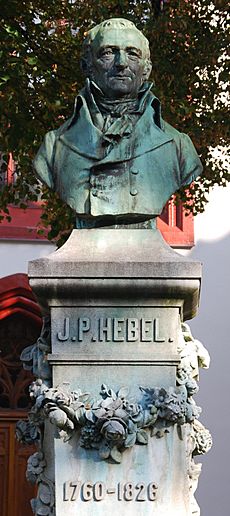Johann Peter Hebel facts for kids
Johann Peter Hebel (born May 10, 1760 – died September 22, 1826) was an important German writer. He was famous for his short stories and poems written in a local language called Alemannic. He was also a Lutheran church leader and a teacher. His most well-known works include a collection of poems, Allemannische Gedichte, and a book of German tales, Schatzkästlein des rheinischen Hausfreundes (meaning "Treasure Chest of Rhenish Tales").
Hebel was born in Basel. He started school in 1766 and later attended a Latin school. He went to schools in Basel during summer and in nearby Hausen and Schopfheim during winter. After his mother died in 1773, friends helped him finish high school in Karlsruhe in 1778. He then studied to become a church leader.
He worked as a private tutor and an assistant teacher. In 1798, he became a professor and a church official. Hebel was interested in many subjects, like plants and nature. His poems, Allemannische Gedichte, became very popular. He also had great success with his calendar stories. These were published in a yearly book called Rheinländischer Hausfreund. Later in his life, he focused more on religion. He became a high-ranking church leader in 1819. Hebel's last writings were Bible stories for young readers. These were used as school textbooks for many years. Hebel died in 1826 in Schwetzingen. Famous writers like Goethe and Tolstoy admired his work.
Contents
Early Life and Education
Johann Peter Hebel was born on May 10, 1760, in Basel. His parents worked for a wealthy family there during the summer. He spent half his childhood in Basel and the other half in Hausen im Wiesental. In Hausen, his father worked as a weaver in the winters. Hebel once wrote that he learned early on what it meant to be both poor and rich. He learned to be happy with happy people and sad with those who cried. Memories of both places greatly influenced his writing.
Hebel's father died from a sickness called typhus in 1761. His baby sister also died that same year. Hebel started primary school in Hausen in 1766. In 1769, he went to the Latin school in Schopfheim. His teacher there was a church scholar named August Gottlieb Preuschen. During the summer, he attended a church school in Basel. Later, he went to a famous cathedral school. His mother passed away when he was thirteen years old.
In 1774, friends helped Hebel financially. He joined a special high school in Karlsruhe. He graduated from there in 1778. From 1778 to 1780, he studied church teachings in Erlangen. After that, he became a private tutor and an assistant church leader. In 1783, he became an assistant teacher at a school in Lörrach. This school is now named Hebel-Gymnasium in his honor. Hebel became good friends with the headmaster, Tobias Günttert. Through him, Hebel met Gustave Fecht. They had a very close friendship, and he sent her many letters. Hebel never married. However, in his later years, he greatly admired an actress named Henriette Hendel-Schütz. In 1791, he returned to Karlsruhe. He was supposed to become a church official at the Karlsruhe high school. Instead, he was named a "subdeacon," a lower church position. Besides teaching, Hebel sometimes gave sermons at the court. He was very popular there.
Later Life and Career
In 1798, Hebel became a professor and a court church leader. He taught many subjects at the high school. These included botany (the study of plants) and natural history (the study of nature). He was very interested in plants. He kept a collection of dried plants. He also helped organize plant names in a book written by his friend, Karl Christian Gmelin. In Hebel's honor, Gmelin named a plant Hebelia allemannica. Later, the plant was renamed Tofieldia calyculata.
In 1799, Hebel became an honorary member of a group that studied minerals. Three years later, he became a member of a science group in Swabia. When he was young, he enjoyed the writings of Klopstock and Jung-Stilling. Later, he especially liked Jean Paul and Johann Heinrich Voß.
Hebel lived in Karlsruhe until he died. However, he sometimes traveled to other places. He always wished to become a church leader in his home area of Wiesental. But this wish never came true. He even wrote a sermon for a country church in 1820. In it, he wrote that his only wish was to live and die as a pastor in a peaceful town. He wanted to be among honest people. Instead, he felt he was "led higher and higher by an invisible hand." This took him further away from his simple goals.
In 1805, he was offered a Lutheran church position in Freiburg im Breisgau. But he turned it down because the Grand Duke of Baden wanted him to stay. In 1808, he was rewarded by being made director of the high school in Karlsruhe. In 1819, he became a "prelate." This was a top position in the Lutheran church. It also gave him a seat in the Upper House of the Parliament of Baden. As a member of parliament, he focused on education, church matters, and helping society. He later gave a speech when the statehouse in Karlsruhe was dedicated. In 1821, the Lutheran and Reformed Protestant churches in Baden joined together. Hebel strongly supported this. His position as the prelate of the united Protestant church was safe.
Hebel's health got worse after 1815. In 1826, he traveled to Heidelberg and Mannheim to check on school exams. He died on September 22, 1826, in nearby Schwetzingen. His grave is there.
Writings
Alemannic Poems
Hebel started his main writing work around the late 1700s. After a trip to Wiesental in 1799, he felt a strong desire for his homeland. This inspired him to write Allemannische Gedichte. He used the spelling Allemannische for the dialect. These 32 poems were "for friends of the rural way of life." They were written in Alemannic, the local language of Wiesental.
Hebel could not find a publisher in Basel willing to print the book in Alemannic. So, the collection was finally published in 1803 in Karlsruhe. This happened after Hebel and his friends gathered enough advance orders. The first edition was published without the author's name. Hebel might have been worried about getting a simple, country image.
In Allemannische Gedichte, Hebel showed the daily life and customs of his home region. The poems covered topics from describing the Wiese River to praising the Breisgau area. They also talked about his work in the ironworks in Hausen. Perhaps the most famous poem is "Die Vergänglichkeit" (The Transience of Things). It is a dialogue about death. In it, the father (called Ätti in Alemannic) tells his son (Bueb) a story. The story is about how a great town like Basel will eventually fade away. Hebel also included his experience of his mother's death. The conversation between Ätti and Bueb happens on the road where Hebel's mother had died.
Allemannische Gedichte was very successful. A new edition was published a year later, this time with Hebel's name on it. When Hebel read the poems aloud to Duke Charles Frederick, the duke praised them. Hebel was amazed at how well the duke knew all the villages and small places. Famous poets like Jean Paul (1803) and Goethe (1804) wrote good reviews of the poems. Hebel was very happy about this success. He wrote in a letter that he felt proud and happy. He was glad he could make his local language, which was often looked down upon, so famous and artistic.
Calendar Stories
Hebel's second famous work is his calendar stories. He started writing these in 1803 for the Badische Landkalender. From 1807, he wrote them for its newer version, the Rheinländischer Hausfreund. This old calendar was not selling well in the early 1800s. Hebel was part of a group asked to suggest improvements. After many talks, Hebel became the editor of the new calendar. It was first released in 1807.
One of the biggest improvements was to have more text. This included "instructive news and funny stories." Hebel wrote about 30 of these stories each year. They became very popular. The Schatzkästlein des rheinischen Hausfreundes was published in 1811. It was a collection of the most interesting of these stories. More editions followed in 1816 and 1827. The calendar stories included news, short stories, jokes, and changed fairy tales. They were meant to both entertain and teach good morals.
The best-known of Hebel's calendar stories are "Unverhofftes Wiedersehen" (Unexpected Reunion) and "Kannitverstan" (I Cannot Understand). A philosopher named Ernst Bloch called "Unverhofftes Wiedersehen" "the most beautiful story in the world." In 1815, there was a disagreement. Hebel's story "Der fromme Rat" (Pious Advice), published in 1814, was criticized by some Catholics. They found it offensive. This led to its removal from the calendar. Hebel then stopped being the editor. He wrote far fewer calendar stories after that. However, in 1819, he wrote more than ever to help that year's issue of the Rheinländischer Hausfreund be published.
Bible Stories
After the calendar stories, Hebel wrote Biblische Geschichten (Bible Stories). This was a new school book for Lutheran religious education. He wanted it to be clearly written. He also wanted it to tell Bible stories in an exciting way for children aged ten to fourteen. It took him five years to write. The book was finished and released in 1824. It was used as a textbook in schools until 1855.
See also
 In Spanish: Johann Peter Hebel para niños
In Spanish: Johann Peter Hebel para niños





